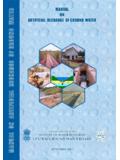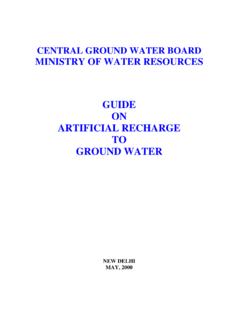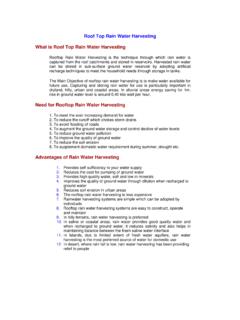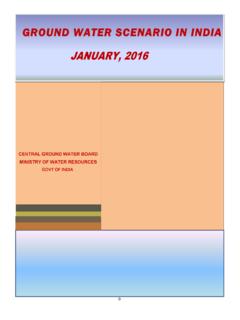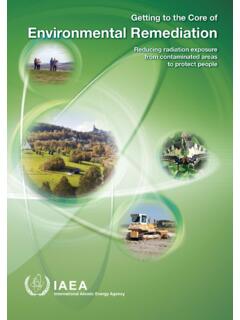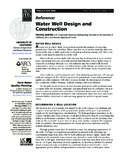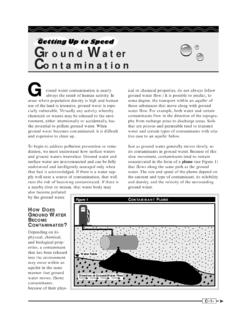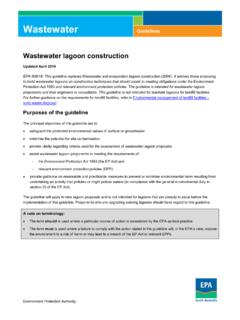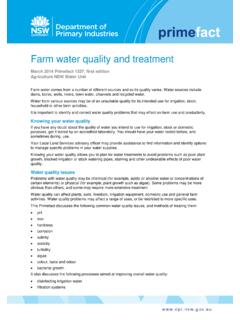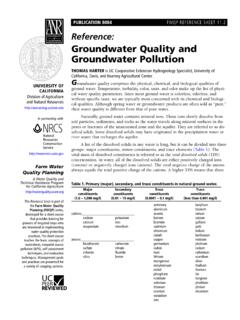Transcription of GROUND WATER QUALITY FEATURES OF THE COUNTRY
1 GROUND WATER QUALITY FEATURES OF THE COUNTRY Introduction GROUND WATER is an essential and vital component of our life support system. The GROUND WATER resources are being utilized for drinking, irrigation and industrial purposes. There is growing concern on deterioration of GROUND WATER QUALITY due to geogenic and anthropogenic activities. The QUALITY of GROUND WATER has undergone a change to an extent that the use of such WATER could be hazardous. Increase in overall salinity of the GROUND WATER and/or presence of high concentrations of fluoride, nitrate, iron, arsenic, total hardness and few toxic metal ions have been noticed in large areas in several states of India. GROUND WATER contains wide varieties of dissolved inorganic chemical constituents in various concentrations as a result of chemical and biochemical interactions between WATER and the geological materials through which it flows and to a lesser extent because of contribution from the atmosphere and surface WATER bodies.
2 GROUND WATER QUALITY in India GROUND WATER in shallow aquifers is generally suitable for use for different purposes and is mainly of Calcium bicarbonate and mixed type. However, other types of WATER are also available including Sodium-Chloride WATER . The QUALITY in deeper aquifers also varies from place to place is generally found suitable for common uses. Only in some cases, GROUND WATER has been found unsuitable for specific use due to various contaminations mainly because of geogenic reasons. The main GROUND WATER QUALITY problems in India are as follows. Inland Salinity Inland salinity in GROUND WATER is prevalent mainly in the arid and semi arid regions of Rajasthan, Haryana, Punjab and Gujarat and to a lesser extent in Uttar Pradesh, Delhi, Madhya Pradesh Maharashtra, Karnataka , Bihar and Tamil Nadu. About 2 lakh area has been estimated to be affected by saline WATER of Electrical Conductivity in excess of 4000 S/cm.
3 There are several places in Rajasthan and southern Haryana where EC values of GROUND WATER is greater than 10000 S /cm making WATER non-potable. Inland salinity is also caused due to practice of surface WATER irrigation without consideration of GROUND WATER status. The gradual rise of GROUND WATER levels with time has resulted in WATER logging and heavy evaporation in semi arid regions lead to salinity problem in command areas. As per recent assessment about m ha of the area under surface WATER irrigation projects is WATER logged or threatened by WATER logging. Coastal Salinity Coastal areas represent zones where land and sea meet and comprises variety of complex environments including deltas, estuaries, bays, marshes, dunes and beaches. Coastal aquifers have boundaries in contact with seawater and are always under dynamic equilibrium with it.
4 Withdrawal of fresh GROUND WATER from these aquifers may result in inequilibrium resulting in intrusion of saline WATER in coastal aquifers. The Indian subcontinent has a dynamic coast line of about 7500 km length. It stretches from Rann of Kutch in Gujarat to Konkan and Malabar coast to Kanyakumari in the south to northwards along the Coromandal coast to Sunderbans in West Bengal .The western coast is charactrised by wide continental shelf and is marked by backwaters and mud flats while the eastern coast has a narrow continental shelf and is characterized by deltaic and estuarine land forms. GROUND WATER in coastal areas occurs under unconfined to confined conditions in a wide range of unconsolidated and consolidated formations. Normally, saline WATER bodies owe their origin to entrapped sea WATER (connate WATER ), sea WATER ingress, leachates from navigation canals constructed along the coast, leachates from salt pans etc.
5 In general, the following situations are encountered in coastal areas i. Saline WATER overlying fresh WATER aquifer ii. Fresh WATER overlying saline WATER iii. Alternating sequence of fresh WATER and saline WATER aquifers In India, salinity problems have been observed in a number of places in coastal areas of the COUNTRY . Problem of salinity ingress has been noticed in Minjur area of Tamil Nadu and Mangrol Chorwad- Porbander belt along the Saurashtra coast. In Orissa in an 8-10 km. wide belt of Subarnrekha, Salandi, Brahamani outfall regions in the proximity of the coast, the upper aquifers contain saline horizons decreasing landwards. Salinity ingress is also reported in Pondicherry region, east of Neyveli Lignite Mines. Some of the options available for removal of salinity from drinking WATER are i) Electrodialysis ii) Reverse Osmosis iii) Ion exchange Fluoride Fluorine is the lightest member of the halogen group of elements.
6 Fluorite (CaF2) is a common fluoride mineral. This mineral has a rather low solubility and occurs in both igneous and sedimentary rocks. Apatite (Ca5 ( Cl, F, OH ) ( PO4)3,) commonly contains fluoride. Most fluorides are sparingly soluble and are present in natural WATER in small amounts. High concentration of fluoride in GROUND WATER beyond the permissible limit of mg/L is a major health problem in India. Nearly 90% of rural population of the COUNTRY uses GROUND WATER for drinking and domestic purposes and due to excess Fluoride in GROUND WATER (Table-1), a huge rural population is threatened with health hazards of Fluorosis. Table 1. Occurrence of Fluoride in GROUND WATER of India Sl. No. State No. of District Affected Districts 1. Andhra Pradesh 16 All districts except Adilabad, Nizamabad, West Godavari, East Godavari, Vishakhapatnam, Srikakulam, Vizianagaram 2.
7 Assam 2 Karbi Anglong,Nagaon 3. Bihar 5 Daltonganj,Gaya,Rohtas,Gopalganj,Paschim Champaran 4. Chhatisgarh 2 Durg, Dantewara 5. Delhi 7 Central, South, West, East, South-west, North West, North East zones 6. Gujarat 18 All districts except Dang 7. Haryana 11 Rewari, Faridabad, Karnal, Sonipat, Jind, Gurgaon, Mohindergarh, Rohtak, Kurukshetra, Kaithal, Bhiwani8. Jammu & Kashmir 1 Doda 9. Jharkhand 4 Giridih, Palamau,Pakur,Sahabganj 10. Karnataka 14 Dharwad,Gadag,Bellary,Belgaum,Raichur, Bijapr,Gulbarga,Chikmaglur,Mandya, Bangalore (rural), Mysore, Manglore, Kolar, Shimoga 11. Kerala 2 Palghat, Allepy 12. Maharashtra 8 Chandrapur, Bhandara, Nagpur, Jalgaon, Buldhana, Amravati, Akola, Yavatmal 13. Madhya Pradesh 13 Shivpuri,Jhabua,Mandla,Dindori,Chhindwar a,Dhar, Vidisha, Sehore, Raisen, Mandsour, Neemuch, Ujjain, Seoni 14. Orissa 18 Phulbani, Koraput, Dhenkenal, Angur, Boudh, Nayagarh, Puri,Balasore, Bhadrak, Bolangir, Ganjam, Jagatpur, Jajpur, Kalahandi,Keonjhar, Kurda, Mayurbhanj, Rayagada 15.
8 Punjab 9 Mansa,Faridkot,Bhatinda,Muktsar,Moga,San grur, Ferozpur, Ludhiana, Amritsar 16. Rajasthan 32 All districts 17. Tamil Nadu 8 Salem, Erode, Dharmapuri, Coimbatore, Tiruchirapalli, Vellore, Madurai, Virudunagar 18. Uttar Pradesh 7 Unnao,Agra,Meerut,Mathura,Aligarh,Raibar eli , Sonbhadra 19. West Bengal 7 Birbhum,Bardhman, Bankura, Purulia, Malda, & To combat the growing problem of fluorosis, it is of utmost importance to understand the distribution and occurrence of fluoride in GROUND WATER and work out strategies for its mitigation and management. Some of the options available for removal of fluoride from drinking WATER are i. Adsorption ( Activated Alumina) ii. Ion Exchange iii. Nalgonda Technique iv. Membrane ( Reverse Osmosis) v . Electro dialysis vi. Alternate Fluoride free aquifer Arsenic Arsenic and its compounds are widely used in pigments, as insecticides and herbicides, as an alloy in metals and chemical warfare agents.
9 Though synthetic organic compounds have now replaced arsenic in most of the uses, arsenic is still an element of interest in terms of environmental QUALITY . Arsenic is a metalloid. The common valancy of arsenic in unpolluted GROUND WATER of geogenic origin are +III & +V as hydrolysis species The dissociation constant of As(III) and As(V) acids are quite different The fact that dominant dissolved species are either uncharged or negatively charged suggests that adsorption and ion exchange will cause little retardation as these species are transported along GROUND WATER flow path. Organic arsenic compounds such as methyl arsenic acid and dimethyl arsenic acid are not common in GROUND WATER . The occurrence of Arsenic in GROUND WATER was first reported in 1980 in West Bengal in India. In West Bengal, 79 blocks in 8 districts have Arsenic beyond the permissible limit of mg/L.
10 About 16 million people are in risk zone. The most affected districts are on the eastern side of Bhagirathi river in the districts of Malda, Murshidabad, Nadia, North 24 Parganas and South 24 Parganas and western side of the districts of Howrah, Hugli and Bardhman. The occurrence of Arsenic in GROUND WATER is mainly in the intermediate aquifer in the depth range of 20-100m. The deeper aquifers are free from Arsenic contamination. Apart from West Bengal, Arsenic contamination in GROUND WATER has been found in the states of Bihar, Chhatisgarh and Uttar Pradesh &Assam. Arsenic in GROUND WATER has been reported in 12 districts In Bihar, 5 districts in and one district each in Chhatisgarh & Assam states. The occurrence of Arsenic in the states of Bihar, West Bengal and Uttar Pradesh is in Alluvium formation but in the state of Chhatisgarh, it is in the volcanics exclusively confined to N-S trending Dongargarh-Kotri ancient rift zone.
